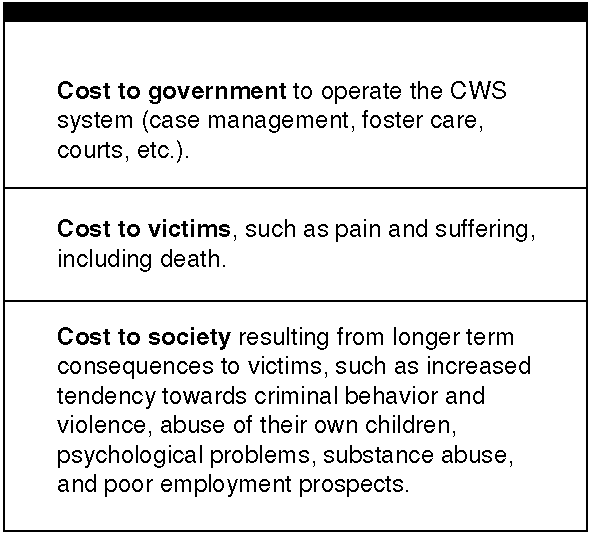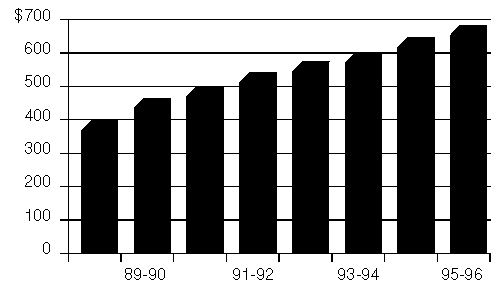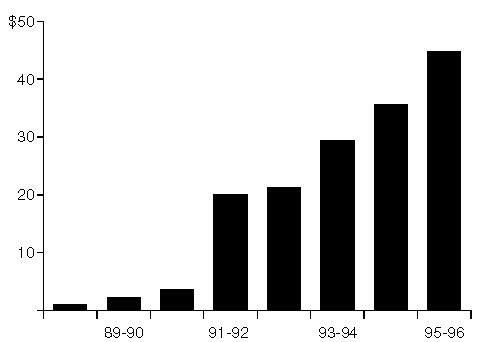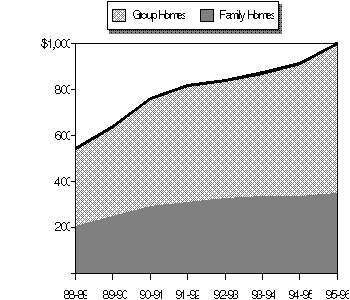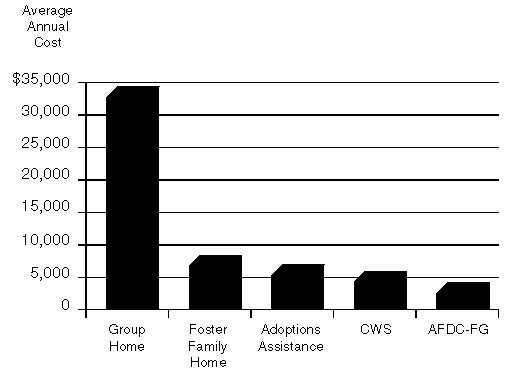It is difficult to measure the real costs and consequences
of child abuse and neglect. The consequences can be quite
varied and long-term in nature; and expenditure data understates the
full costs because many incidents of child abuse/neglect go
unreported or undetected.
With this caveat, we provide data on the direct costs
to government. In 1995-96, California is estimated to spend
about $1.7 billion, all funds (state, local, and federal), to provide
foster care services to children and to fund the CWS Program.
This does not include related costs such as expenditures
for the juvenile courts, prevention, health care, and adoptions
programs. Also excluded are government costs resulting from
the potential indirect effects of child abuse and neglect, such as
the costs to the criminal justice system due to increased
criminal behavior.
Assessment of the Child Welfare
Services System
The purposes of the CWS Program are to (1) reduce
unnecessary foster care placements, (2) safely reunify foster care
children with their families, (3) increase the stability of foster care
placements, and (4) place more foster care children into
adoptions, when appropriate. Determining the extent to which the
CWS system has achieved those goals is somewhat problematic. This
is in part because much of the data that is collected in the
CWS system relates to "inputs" (such as, the number of social
worker visits with the child), rather than outcomes. While these
inputs tend to be measurable, they do not provide a good assessment
of the success of the program.
Data on outcomes are relatively difficult to develop.
Nevertheless, state law requires the development of performance
standards and outcome measures for determining the effectiveness
and efficiency of the foster care program. The standards, however,
do not have to be developed until the statewide CWS case
management system is completed in October 1997.
While additional information to assess the performance of
the CWS system should be forthcoming from the case
management system, some outcome-related data are available currently and
are summarized in the following charts.
Many Reports of Abuse Are
Responded To Within the First Day
January 1993
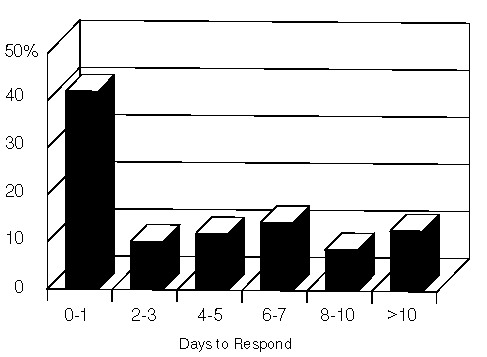
- State law requires that county welfare departments provide an
in-person response to reports of child abuse/neglect "immediately" if there
is immediate danger to a child or within ten calendar days for all
other reports. (Statutes do not define
"immediately.") An in-person response is not required if the county welfare department determines that such
a response is not appropriate.
- In January 1993, about 40 percent of in-person responses to reports
of child abuse/neglect were made within the first day. About 13 percent
of the responses were made after 10 days. This may be partly due to
inadequate staffing in the emergency response component of the CWS
Program. (It should be noted, however, that counties have the flexibility
to allocate staff resources among the four CWS components
and, therefore, the ability to shift staff to the emergency response program.)
In cases where the county is not responding in a timely manner, the
Department of Social Services may require the county to develop a
corrective action plan.
Percent of Children Previously
In the CWS Program Is Increasing
1994-95
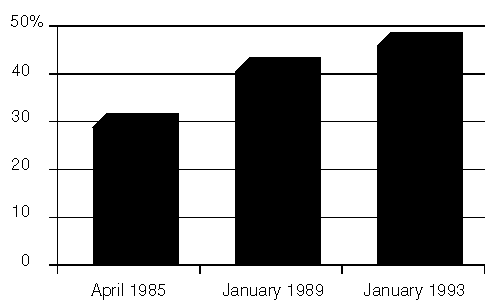
- One measure of the success of the CWS Program is the extent
to which children previously served by the program do not return to the
system. The data show, however, that the percent of children in
the emergency response and family maintenance components who
were previously in the CWS Program has increased substantially, from
29 percent in April 1985 to 46 percent in January 1993.
- Also, while not shown in this graph, of those children who were
previously in the CWS Program, 37 percent of the 1993 cases had
been in the system on three or more separate occasions, compared to
27 percent of the 1985 cases.
- The increased recidivism may be partly due to changes in the
CWS caseload. For example, there may have been an increase in the
number of families who are more difficult to serve effectively (for
example, a higher proportion of cases where children have severe
behavioral problems or parents have substance abuse problems).
Little Improvement in Foster Care Recidivism
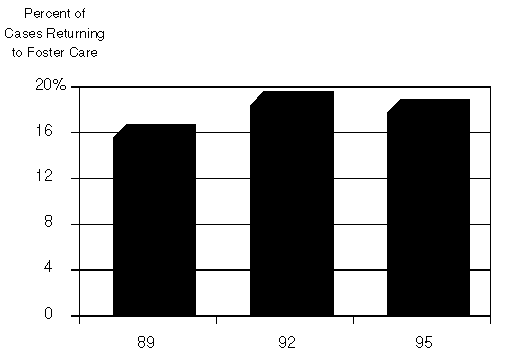
- Another measure of the success of the CWS Program is the extent
to which children do not return to the foster care program. Between
1989 and 1995, the percent of cases which returned to foster care
remained essentially unchanged, hovering close to 17 percent.
One-Third of Foster Care Children
Have Had Three or More Placements
1993-94
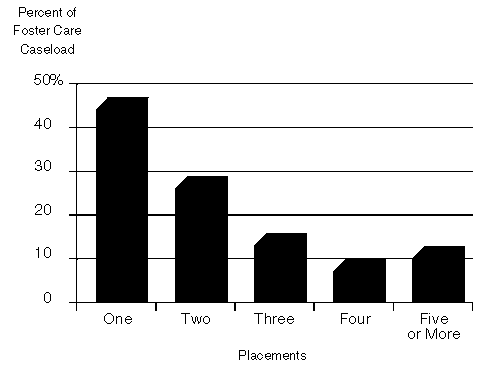
- Another measure of the success of the CWS Program is the extent
to which children are not moved from one foster care placement to
another. In 1993-94, children in foster care had experienced, on
average, two different placements. About 30 percent had experienced
three or more placements. This trend has remained steady over the last
five years.
- There are a variety of reasons for multiple placements, including
behavioral problems of the child, lack of appropriate placement
options, and improper matching of the child and placement.
Gap Between Family Reunifications and
New Foster Care Cases Remains Unchanged
In Thousands
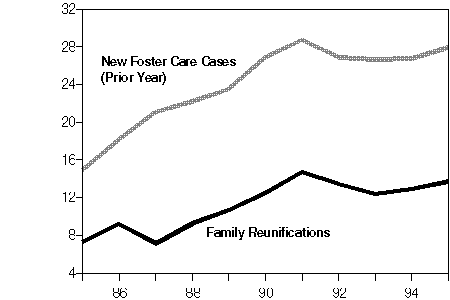
- Another measure of the success of the CWS Program is the extent
to which children in foster care are reunified with their families.
Despite efforts of many counties to increase family reunifications,
the gap between new foster care cases and family reunifications has
remained the same over the last 10 years. Specifically, the number
of children who have not been reunified with their families has
remained around 51 percent of all new foster care cases.
Adoptions Peaked in 1991-92
In Thousands
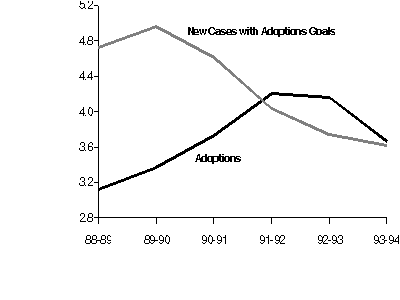
- The total number of adoptions peaked in 1991-92 (about 4,200
children), decreased slightly in 1992-93, and dropped sharply in 1993-94.
- In addition, there has been a trend toward fewer cases with
adoption as a goal. The reduction in the number of new cases with adoption
as a goal may be partly due to an increase in the number of children
who are considered "difficult to adopt," due to factors such as age,
ethnicity, and mental or physical handicaps.
CWS Program Performance and
Policy Implications
It is difficult to assess comprehensively the performance
of the CWS Program because outcomes are often hard to
measure and existing data are limited. Nevertheless, the data that we
have presented in this report can be used to draw some
conclusions about program performance and the major policy implications
that stem from our findings.
Emergency Response
Investigating Cases of Abuse/Neglect
One of the functions of the CWS Program is to respond
to reports of child abuse and neglect. Ideally, only those reports
that do not constitute abuse or neglect are "screened out" in the
initial response stage. As shown on page 21, there is significant
variation among the counties in the percentage of reports that are
"screened out" at the initial contact stage. Among the large counties,
it ranges from 19 percent in Los Angeles County to 55 percent
in Contra Costa County. One interpretation of the data is that
some counties are screening out too many reports of abuse. On
the other hand, one might conclude that some counties are
not screening out enough reports (in other words, investigating
cases where no abuse has occured). We believe this is an area
that deserves further research.
Timely In-Person Response
Another outcome measure in the CWS Program is
timely in-person response to reports of abuse and neglect. As shown
on page 42, about 40 percent of in-person responses were
made
within the first day, indicating that a significant number of
reports are addressed immediately. We note, however, that 13 percent
of the responses were made after the statutory 10-day timeframe.
In cases where the county is not responding in a timely manner,
the Department of Social Services has the authority to require
the county to develop a corrective action plan.
Family Maintenance and Reunification
Reducing Recidivism in the CWS Program
As shown on page 43, the percentage of children returning
to the CWS Program has increased significantly over the years,
from 29 percent in 1985 to 46 percent in 1993. These data suggest
that the program has not been effective in preventing reabuse
and neglect in a significant and growing number of cases.
Currently, however, there is a lack of information identifying those
factors which contribute to the success of family maintenance
and reunification services, thereby reducing reabuse and neglect.
We believe that collecting such performance data could
ultimately improve the results of family maintenance and
reunification efforts.
Increasing Family Reunifications
While family reunifications have increased, they have
not increased relative to the growth in new foster care cases (see
page 46). Although there are cases where it is not appropriate to
return children to their families, there are many instances where
reunification is in the children's best interests. As some child
welfare professionals have indicated, more children in long term
foster care (those children for whom family reunification had
been attempted and failed) could return home if
ongoing support services, such as counseling, were provided to the
affected families.
Currently, very few families receive ongoing services when
a child is returned home. It is likely that some children who are
in long-term foster care could be reunified with their families
if counties had more flexibility to use foster care funds to
provide services to the families rather than to pay for foster care
placements. Therefore, we recommend that counties be allowed to
use state foster care funds to provide these services to children
and their families after reunification.
We note that Chapter 105, Statutes of 1988 (AB
558, Hannigan) established a Family Preservation pilot program
to provide intensive short-term family maintenance and
family reunification services by giving counties more flexibility in
the use of foster care funds. Specifically, counties are authorized
to use up to 25 percent of the state's share of projected foster
care costs to fund family preservation support services.
Generally, these services are not targeted to children in long term foster care.
Our proposal, however, would focus these services on
such children.
Evaluating The Effectiveness of Prevention Programs
In 1982, the Legislature established the Child Abuse
Prevention Program to provide prevention and intervention services
to children at risk of abuse/neglect. Each year, about $9 million
from the General Fund is allocated to counties to fund
community-based public and private agencies that provide prevention
and intervention services. However, no evaluation exists that can
help determine whether these programs and services are
effective. Consequently, we suggest that the Legislature require that
a portion of the funds allocated to the programs be used to
support independent evaluations to determine the effectiveness of
these programs.
Foster Care
Minimizing the Use of Foster Care
One of the goals of the CWS Program is to minimize the
use of foster care placements in serving abused children and
instead maintain or reunify such children with their families
when appropriate. The data, however, suggest that the program has
not been successful in achieving this goal since: (1) foster
care placement rates (relative to the population of children)
have increased since 1988, (2) the proportion of children in the
CWS system who are being placed in foster care (rather than
receiving support services at home) has been increasing, and (3)
family reunifications (returning foster care children to their parents)
have not increased relative to the growth in foster care cases.
(See pages 30, 23, and 46.) These trends are not likely to
be reversed until the effectiveness of family maintenance and
reunification services is improved.
Providing a Stable Living Environment for Those Children
Who Are in Foster Care
Another measure of the success of the CWS Program is
the extent to which multiple foster care placements for the same
child are minimized. The data show that in 1993-94, about one-third
of the children in foster care had experienced three or more
different placements and 10 percent had five or more placements (see
page 45). This trend has remained steady since 1988-89.
We note, with respect to this issue, that Chapter 1294,
Statutes of 1989 (SB 370, Presley) requires the Department of
Social Services to develop a Level of Care Assessment tool. The
purpose of this tool is to facilitate the assignment of a foster care child
to the most appropriate placement, thereby reducing the chances
of multiple foster care placements. Although there is no
statutory
completion date, the department has not provided the
Legislature with a project status report which was due in January 1995.
We find no justification for the delay in completing this project.
Increasing the Use of Foster Family Homes, In Lieu of
Group Homes
When placing a child in foster care, current law gives
priority to more family-like foster care settings and requires placement
in foster family homes instead of group homes, when
appropriate. As shown on page 26, however, the proportion of children
placed in foster family homes has actually decreased slightly over
the years, from 88 percent in 1984 to 86 percent in 1995.
Although group homes may be the most appropriate placement for
some children, some child welfare professionals believe that there
are children in group homes who could be placed in foster
family homes if support services were provided to the foster parent.
This could result in substantial savings to the government because
the costs for a group home placement are almost five times the
costs for a foster family home placement. We also note that the
occupancy rates for foster family agency homes are much lower than
for group homes, suggesting that foster parent availability may not be
a major obstacle in efforts to move more children out of group
homes and into foster family homes. (See pages 40 and 25.)
We note, in this respect, that there is a pilot program
designed to accomplish the movement of children from group homes
to foster family homes. The program allows certain foster
family agencies (FFAs) to receive higher foster care grants than
other FFAs in order to provide a higher level of care to
children. Evaluations of the pilot program have shown positive results,
and Chapter 832, Statutes of 1995 (SB 969, Watson) provides
for statewide expansion of the program, at the option of the counties.
Assessing the Need for Independent Living Program Services
Children who are emancipated from the foster care
system (generally at age 18) must have a service plan to help
them transition to independent living. As the figure on page 34
shows, however, less than half of the eligible children receive
services through the state's Independent Living Program (ILP).
In our field visits, child welfare professionals have
indicated that additional funds are needed to expand the ILP. We
note, however, that data are not sufficient to determine whether
the program is effective. Current law requires the Department
of Social Services to complete an evaluation of the ILP and
develop recommendations on how independent living services could
better prepare foster youth for independence. The evaluation was due
in January 1995 but has not been completed. This evaluation
is important in order to help the Legislature determine the
appropriate funding level for the program. We find no justification for
the department's delay in providing the report.
Adoptions
Maximizing the Use of Adoptions
Another goal of the CWS Program is to increase
adoptions for children who cannot be reunified with their families. The
data suggest that the program has been successful in
increasing adoptions since 1988-89. However, the number of new cases
with adoption as the goal has decreased significantly since
1988-89 (page 47), even though foster care caseloads have continued
to increase. In response, some counties have increased their
efforts to review the case plans of children who were categorized as
not being adoptable, in order to explore possibilities of adoption. As
a result, some of these children have been recommended,
and subsequently placed, for adoption. We believe that such
reviews
should be encouraged as a way to help increase adoptions
where appropriate.
Conclusion
How Well Is the CWS Program Performing?
Our review indicates that the preponderance of
available performance-related measures suggest the need for
improvement in the state's CWS Program. To summarize:
- There is significant variation among the counties in the percentage
of reports of abuse/neglect that are "screened out" at the initial
contact stage.
- The percentage of children returning to the CWS
Program (recidivism) is increasing.
- Family reunifications are not increasing relative to the growth in
new foster care cases.
- Reliance on foster care is increasing (as measured by placement
rates and the percentage of the CWS children who are placed in foster care).
- A significant number of foster care children have experienced
multiple placements, indicating a lack of stability in their living
environments.
- The use of group homes is increasing more than family homes,
which is contrary to one of the statutory placement priorities for the
Foster Care Program.
- A significant number of foster care children who are eligible for
the ILP are not receiving these services.
Reversing these trends will not be an easy task. The
provision of additional resources could help; but given the
competing demands for such resources it is important that available
funding -- whether new or existing -- be used effectively. In this
respect, there have been some positive developments recently -- the
new statewide automation system and the expansion of the FFA
pilot program, for example. We believe, however, that
additional efforts are needed, such as the development of better
placement
mechanisms, more intensive reviews of case plans to determine
if foster children can be adopted, and giving counties more
flexibility to use foster care funds for CWS support services in order
to prevent the need for foster care placements. Finally, we
believe that it is important to evaluate child abuse prevention
programs, particularly those efforts designed to address the causal
factors related to child abuse and neglect, such as drug abuse.
Return to the Table of Contents
Return to Part III, The Child Welfare Services System, Part B
Return to LAO Home Page


